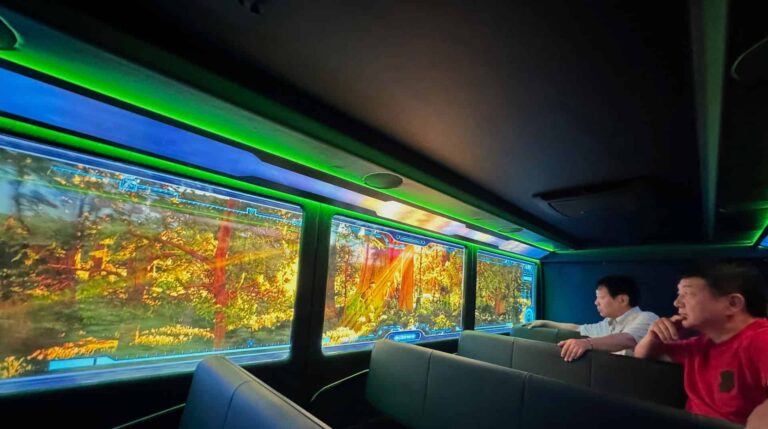
Building a Shared Immersive AR Theater at Yuanmingyuan Park in Beijing
___
Yuanmingyuan Park—Beijing’s Old Summer Palace—sprawls across 2.2 square kilometers, destroyed by invading forces in 1860, its ruins are a quiet monument to the Qing Dynasty’s splendor. Ten million visitors a year wander its paths, hungry to connect with that lost past. In August 2024, we launched Chrono Craft: a fleet of 20-seat augmented reality immersive busses that don’t just tour the park—they transform it into a living, shared theater. Over 12 months, we built a platform from scratch, fusing cutting-edge hardware, custom software, and a location-synced narrative to pull passengers into a communal journey through time. Here’s how we did it.
The Vision
Immersive entertainment often stumbles—VR headsets isolate, and theme park rides ignore the world beyond their tracks. After a decade of digital silos (social media, smartphones), people crave real interaction, not more screens strapped to their faces. We saw a gap: a platform that brings people together, rooted in place, amplifying the real world instead of replacing it. Yuanmingyuan’s story—its imperial peak, its fiery end—offered the perfect canvas. Our answer was a mobile theater where the park stays visible, overlaid with historical scenes through transparent TOLED screens. Through this immersive AR mobile experience, a time-travel tale unfolds, paced by the bus’s motion, with 3D audio and lighting enveloping passengers in a shared journey. It’s not about escaping reality—it’s about enhancing it, together.
The Platform
This wasn’t just a bus retrofit—it was a new kind of machine. First, we tackled the hardware. We sourced displays (three TOLED screens per bus), a 12-speaker array with dual subwoofers, sensors (GPS, INS), and a hydrogen power system—all pieced together within a few months. The prototype took two months to build, a rough shell proving the tech could talk. Three more months refined it: a custom interior, hydrogen fully integrated, and displays calibrated. Then, over four months, we rolled out 22 immersive experience busses, each like a self-contained theater.
But hardware’s only half the battle. We engineered a software ecosystem to drive it—synchronizing every element to the park’s geography. GPS and INS sensors track geo-markers, triggering scenes as the vehicle rolls past specific ruins or gardens. A custom media engine blends AR, linear video, real-time 3D objects (palaces rising from rubble), and dimensional sound effects, all pinned to the real world outside. We built authoring tools from the ground up, enabling designers to drop cues along the route—each a mix of visuals, narration, voiceovers, and lighting, fine-tuned to play in sync. Internal clocks calculate distances between cues, estimating arrival times to slot in “bridge content” (like narration) when traffic or crowds slow the ride. This isn’t a time-based editing system—it’s position-based, alive to the bus’s every move.
This project took a village: hardware and software engineers, designers, and artists from China, Korea, Europe, and the US. Software and audio systems took six months to develop, with three more for debugging. The story and content—soundtrack, AR, 3D audio, visuals—spanned nine months from sketch to polish. The result? A platform that’s not just a vehicle, but a new way to tell stories in motion and a testament to a true AR experience.
The Experience
Picture this: you’re aboard, the park sliding past your window. TOLED screens flicker to life—ghostly Qing palaces rise where ruins now sit, their edges blending into the real horizon. A 12-speaker array throws sound from all angles—birds in the trees, a distant cannon’s boom—no central sweet spot, just an enveloping presence. It feels so real that you flinch. LEDs shift from warm dawn to smoky dusk, cueing the mood. The narrative kicks in: a “time bus” adventure, weaving historical facts with a dash of fantasy, all triggered by where you are. One moment, you’re rolling past a lake; the next, it’s 1850, and a royal barge drifts across the glass. Everything you see looks so realistic and native, that you consider asking the person seated next to you if you all are in a time machine. Everyone gasps together, and laughs together—no headsets, no isolation.
Since launch, 22 busses have carried tens of thousands through Yuanmingyuan, resurrecting its lost world through AR and 3D. It’s a proof of concept: tech can amplify a place, not bury it. All of the vehicles run on hydrogen power in support of Beijing’s sustainability drive. And it can scale—22 busses today, but the platform’s flexible for more.
Looking Ahead
Why aren’t immersive events or current AR experiences more engaging? Because they lean on tech over story, and solitude over connection. Chrono Craft flips that— location is the star, and shared experience is the glue.
This is just the start of these immersive AR mobile experiences. Theme parks could run these through their lots, studios could turn backlot tours into living films, and trade shows could shuttle attendees through branded worlds. Smaller rigs—golf carts, vans—could also adapt it. As immersive tech grows, this model could bridge digital and physical, proving high-tech doesn’t mean alone.
 Jeff Smith is Concept Creator and Designer, Chrono Craft
Jeff Smith is Concept Creator and Designer, Chrono Craft
 Steve Petersen is Creative Director, Chrono Craft
Steve Petersen is Creative Director, Chrono Craft

